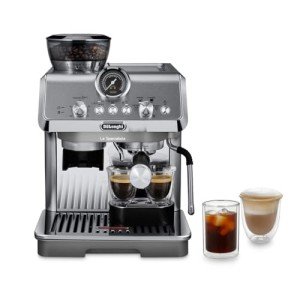The Most Negative Advice We've Ever Seen About Italian Espresso Machines Italian Espresso Machines

Heat Exchange Espresso Machines: A Comprehensive Guide
Espresso machines have actually progressed considerably over the years, dealing with the requirements of home baristas and coffee professionals alike. Amongst these machines, heat exchange espresso machines have actually gained popularity due to their capability to provide constant efficiency and exceptional brew quality. In this short article, we will check out the workings, benefits, and important functions of heat exchange espresso machines, supplying a detailed understanding for both possible purchasers and coffee lovers.
Understanding Heat Exchange Technology
Heat exchange espresso machines run on a distinct principle that permits synchronised water heating for developing and steaming. They are geared up with a single boiler that uses a heat exchanger system. Energy-Efficient Espresso Machines is substantial as it allows users to brew espresso while steaming milk simultaneously, promoting performance in the coffee-making process.
How Does a Heat Exchange Espresso Machine Work?
The procedure begins with the machine's water inlet filling the boiler. As the water heats up, it turns to steam. The ingenious heat exchanger uses hot steam to heat extra water in a separate passage developed specifically for the brew group. This indicates that water can reach the ideal developing temperature level without awaiting the boiler to change. The crucial actions include:
- Water Fill: Water is drawn into the boiler.
- Heating Process: The boiler warms up as water is transformed into steam.
- Heat Exchange: Steam heats water in the heat exchanger tube.
- Brewing: Water from the heat exchanger is pushed through coffee premises, extracting the flavors required for an abundant espresso.
This process allows for fast temperature adjustments and enhanced coffee extraction.
Advantages of Heat Exchange Espresso Machines
Heat exchange espresso machines use numerous benefits, especially for those looking to optimize their coffee experience. Here are some crucial benefits:
- Simultaneous Brewing and Steaming: Users can brew espresso while steaming milk, making it perfect for busy coffee shops and home baristas who value efficiency.
- Temperature level Stability: The boiler's steam pressure helps keep a stable temperature, which is important for constant espresso extraction.
- Adaptability: The design permits fast changing between brewing and steaming, making it easier to produce various coffee drinks, from lattes to cappuccinos.
- User-friendly: Models typically come with available controls, making it feasible for both newbies and experienced baristas to produce quality beverages.
- Professional Quality: Heat exchange machines are often utilized in commercial settings, providing users with high-quality developing performance in your home.
Key Features to Look for in Heat Exchange Espresso Machines
When thinking about the purchase of a heat exchange espresso machine, there are several features that a person must take into consideration:
- Build Quality: Look for machines made from durable materials, such as stainless-steel or brass, ensuring durability.
- Boiler Size: A larger boiler will hold more water and sustain greater output gradually.
- PID Temperature Control: This function assists keep consistent brew temperatures, which can boost the coffee-making process.
- Group Head Design: Machines with a saturated or semi-saturated group head offer better temperature stability.
- Relieve of Use: User-friendly user interfaces and instinctive controls boost the total experience for baristas at all skill levels.
- Steam Wand Quality: A great steam wand with correct insulation and versatility enables much better texturing of milk.
- Water Reservoir Size: Depending on your requirements, think about how frequently you wish to refill the water tank.
Contrast of Popular Heat Exchange Espresso Machines
To much better comprehend the options offered in the market, listed below is a comparison table of some popular heat exchange espresso machines:
| Machine Model | Boiler Size | PID Control | Price Range | User Ratings |
|---|---|---|---|---|
| Profitec Pro 700 | 2.0 L | Yes | ₤ 2,000-₤ 2,500 | 9.5/ 10 |
| Rocket Espresso R58 | 1.8 L | Yes | ₤ 2,400-₤ 2,800 | 9.4/ 10 |
| Elekta Bianca | 1.8 L | Yes | ₤ 2,500-₤ 3,000 | 9.6/ 10 |
| La Spaziale S1 Vivaldi II | 1.5 L | Yes | ₤ 1,800-₤ 2,200 | 9.2/ 10 |
| Bezzera Magica | 1.2 L | No | ₤ 1,600-₤ 1,800 | 9.0/ 10 |
Frequently Asked Questions About Heat Exchange Espresso Machines
What is the main distinction in between a heat exchange and a dual boiler espresso machine?
While both types can brew espresso and steam milk at the same time, dual boiler machines have separate boilers for developing and steaming. In contrast, heat exchange machines make use of a single boiler and a heat exchanger to achieve the exact same function.
Are heat exchange machines suitable for beginners?
Yes! Lots of heat exchange machines are created with user-friendly functions, making them available for beginners. With proper assistance and practice, users can quickly produce quality espresso.
What type of maintenance do heat exchange espresso machines need?
Regular upkeep includes descaling, cleaning up the boiler, examining seals and gaskets, and keeping the group head clean. Routine upkeep ensures durability and constant performance.
Can I use a heat exchange machine for various kinds of coffee drinks?
Definitely! Heat exchange machines enable users to create a variety of coffee drinks, including espresso, lattes, cappuccinos, and more.
Heat exchange espresso machines represent a mix of innovation and tradition, offering coffee enthusiasts with the tools required for crafting the ideal cup. Their ability to concurrently brew and steam, combined with accurate temperature level control, makes them a compelling option for both home baristas and specialists. With the best knowledge on features and upkeep, users can open a world of exquisite coffee experiences, guaranteeing that each sip is as delightful as the last.

